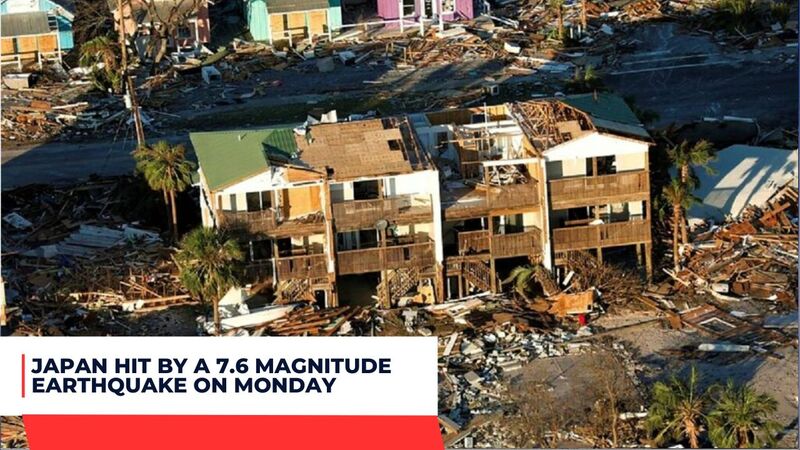On Monday, central Japan was rocked by 21 earthquakes registering 4.0 magnitude or above, the strongest one measuring 7.6. These earthquakes issued tsunami warnings and officials advised residents to move to higher ground immediately.
Public television flashed large letters of “RUN”, warning viewers of imminent danger such as houses collapsing or fires. Prime Minister Fumio Kishida strongly encouraged residents to evacuate.
1. Tsunami in japan
Japan was hit with several strong earthquakes on its western coastline on Tuesday night, the strongest measuring 7.6 magnitude. As a tsunami warning has been issued for coastal areas, public broadcaster NHK advised residents in coastal communities to seek higher ground as soon as possible. Government spokesman Yoshimasa Hayashi confirmed there had been no reports from nuclear plants located there of any irregularities.
Terrifying video posted to social media and broadcast on television showed buildings collapsing into a cloud of dust, with residents hiding under tables as buildings collapsed nearby. There were reports of a large fire in Wajima city with reddish smoke coming out from residential neighborhoods – further exacerbating fear among its population.
Meteorological agency forecasters warned of further major quakes occurring on Honshu’s west coast within days, prompting cell phone providers to suspend service in that region and suspend high-speed rail services as reported by NHK, while fire and landslide risks have also increased dramatically, the Meteorological Agency warned.
2. Collapsed buildings
Central Japan was rocked by 21 earthquakes of magnitude 4.0 or stronger within 90 minutes, the strongest one measuring 7.6 magnitude and sparking tsunami warnings and warnings by authorities for people to seek higher ground. Video footage captured buildings collapsing, cracks appearing in roads, collapsed shrines with terrifying screams coming from nearby and terrified shoppers being thrown to the floor at department stores before train stations experienced flooding due to burst water pipes bursting. This caused mass panic across Japan.
Prime Minister Fumio Kishida pledged that the government would ensure residents’ safety in areas affected by powerful earthquakes during an interview broadcast by public broadcaster NHK. He encouraged local governments to implement damage prevention measures including evacuation of residents. Six cases of buildings collapsing and trapping residents inside have already been reported according to Chief Cabinet Secretary Yoshimasa Hayashi; Japan has strict building regulations intended to withstand earthquakes but some buildings cannot withstand such powerful shockwaves.

3. Fire
Authorities have issued warnings that this earthquake has generated a tsunami that reached the coast, and are encouraging residents to evacuate to high ground or buildings with higher floors. Footage broadcast by NHK seemed to show buildings collapsing in Ishikawa; approximately 36,000 households lost power according to Hokuriku Electric Power utilities provider.
Earthquakes in Japan are frequent due to its location on the Pacific Ring of Fire, where tectonic plates converge and cause surface distortions that eventually release massive energy through earthquakes.
This earthquake hit off Japan’s western coast, prompting major and lower-level tsunami warnings or advisories for Ishikawa as well as lower level warnings or advisories further along its coastline. It shook buildings in Tokyo some 300 km (190 miles away). According to Japan’s meteorological agency, waves reaching 1 metre (3 feet or more) hit shore within about 30 minutes; further tsunamis may follow later on.
4. Power outages
Central Japan was shaken by 21 earthquakes of magnitude 4.0 or greater within 90 minutes, the strongest measuring 7.6. It prompted tsunami alerts and authorities advised residents to relocate to higher ground.
Local media reports of multiple buildings collapsing in Ishikawa prefecture at 4.10 pm local time due to strong earthquakes — the strongest being 4.10 quakes with magnitude 5.8, then shortly afterwards another 6.2-magnitude one, according to US Geological Survey estimates — before broadcasters switched over to emergency programming and advised viewers to evacuate immediately – with NHK broadcaster’s presenter noting: “Your homes and possessions may be valuable, but life should always come first.”
Power companies operating nuclear plants were quickly instructed to halt operations and check for signs of abnormalities, with power companies appearing to confirm Hokuriku Electric Power’s Shika plant located closest to the epicentre as being safe. 33,000 households lost electricity service according to Hokuriku Electric Power while other quakes could also be felt across Tokyo and Nagano prefectures.






